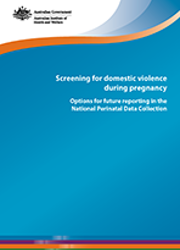Summary
Domestic violence (DV), defined in this paper as 'acts of violence that occur between people who have, or have had, an intimate relationship,' is a leading preventable contributor to death, disability and illness for women of reproductive age (15 to 44 years).
Pregnancy is as an important time for screening for DV. It presents an opportunity to identify DV, as many women will have contact with health-care services and professionals on a regular basis during the antenatal period.
Estimates indicate that around 5% of women (aged 18 and over) experience violence during pregnancy from their previous or current partner. The risk of DV has been found to be higher in pregnant women and in the period following birth, posing serious health risks to both pregnant women and their babies. There is known under-reporting of DV due to its complex and sensitive nature (including patients' reluctance to report) and under- identification by health workers.
Data on DV in pregnancy in Australia are currently poor and inconsistent across jurisdictions, with variations in what is collected and in methods of collection. An opportunity exists to collect higher quality data through the National Perinatal Data Collection (NPDC), which includes data about every woman who gives birth in Australia. These data are important for population level surveillance and for clinical care and outcomes; they can also contribute to researching the association of DV with other maternal and perinatal outcomes. Seeking to improve national data on DV in pregnancy is also timely, in light of the Prime Minister's Advisory Panel on Violence against Women, established in 2015.
The AIHW's National Maternity Data Development Project (NMDDP) aims to enhance the collection of nationally consistent data in the NPDC. As part of the NMDDP, this paper was developed as a guide to the issues that need to be considered in deciding whether and how to collect DV data in the NPDC. The data development process included a literature review, investigation of current approaches in Australia, a discussion paper, a national workshop, and consultation with a working party.
It was found that screening for DV-a process to identify victims of violence or abuse in order to offer interventions that can lead to beneficial outcomes-in the antenatal period already occurs in most Australian jurisdictions. This may be structured or unstructured, and the results of screening are not necessarily recorded in data systems.
Potential approaches to obtaining national data in the NPDC include:
- develop and implement a minimum set of standard questions, based on the questions currently in use across jurisdictions
- seek to implement a nationally consistent screening approach by encouraging all midwives to use a recommended validated DV screening tool
- maintain a flexible screening approach consistent with the National Antenatal Care Guidelines that enables screening in different ways for different populations.
It is recommended that before national data standards are developed for the NPDC, pilot testing and further consultation be conducted to determine the best way to achieve high-quality data, while gaining acceptability among clinicians and mothers.
Preliminary material: Acknowledgments; Abbreviations
1 Introduction
- Background
- Process of identifying options for NPDC data
- Rationale
- Structure of this report
2 Government initiatives in the area of domestic violence
- Maternity services initiatives
- Domestic violence initiatives
3 Definitions of domestic violence and screening
- What is domestic violence?
- What is screening?
4 Literature review to identify issues in screening for domestic violence
- Why pregnancy is an important time to screen
- Screening benefits and effectiveness
- Screening tools and methods
- Timing and frequency of screening
- Coexistence of DV and multiple psychosocial factors
5 Domestic violence data and data collection
- Data gaps
- Data quality
- Potential role of the NPDC in filling data gaps
6 Current situation for screening and reporting
- Review of screening tools/questions in use
- Recording of screening outcome
7 Moving towards nationally consistent data collection and reporting
- Potential NPDC data
- Potential screening approaches
- Validated tool review
- Preferred tools: HITS and HARK
- Preferred collection method
8 Other data development issues
- Enablers for screening
- Mandatory reporting
- Indigenous issues
- Relationship to other psychosocial data items
- Data collection and clinical practice
9 Next steps
- Further consultation
- Development of national data standards
- Staged implementation
Appendixes
Appendix A: NMDDP Advisory Group
Appendix B: Feedback from jurisdictional consultations
Appendix C: Screening for Domestic Violence Workshop attendees
Appendix D: Screening for Domestic Violence Working Party
Appendix E: Jurisdictional legislation/policies/strategies
Appendix F: Existing data sources
Appendix G: Resources
Appendix H: Definition of domestic violence from the National Plan to Reduce Violence against Women and their
Children 2010–2022
Appendix I: Validated screening tool summary
End matter: References; List of tables; List of figures



